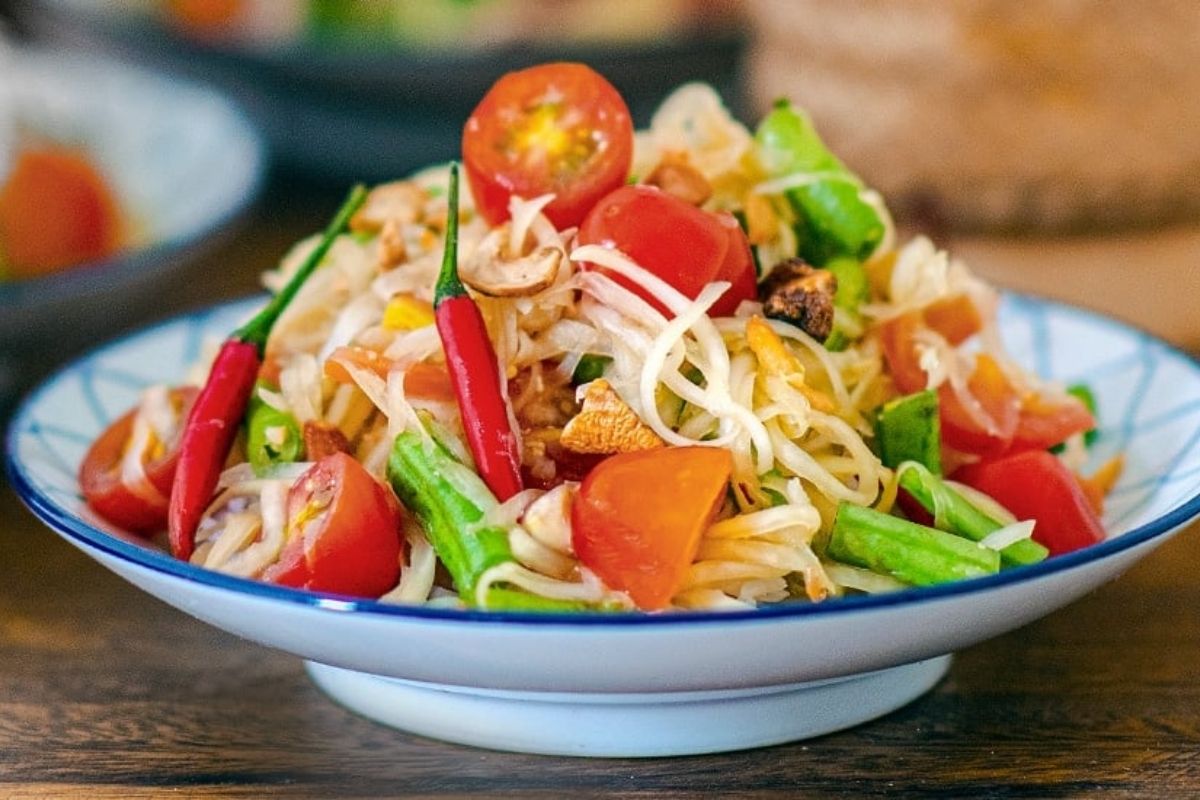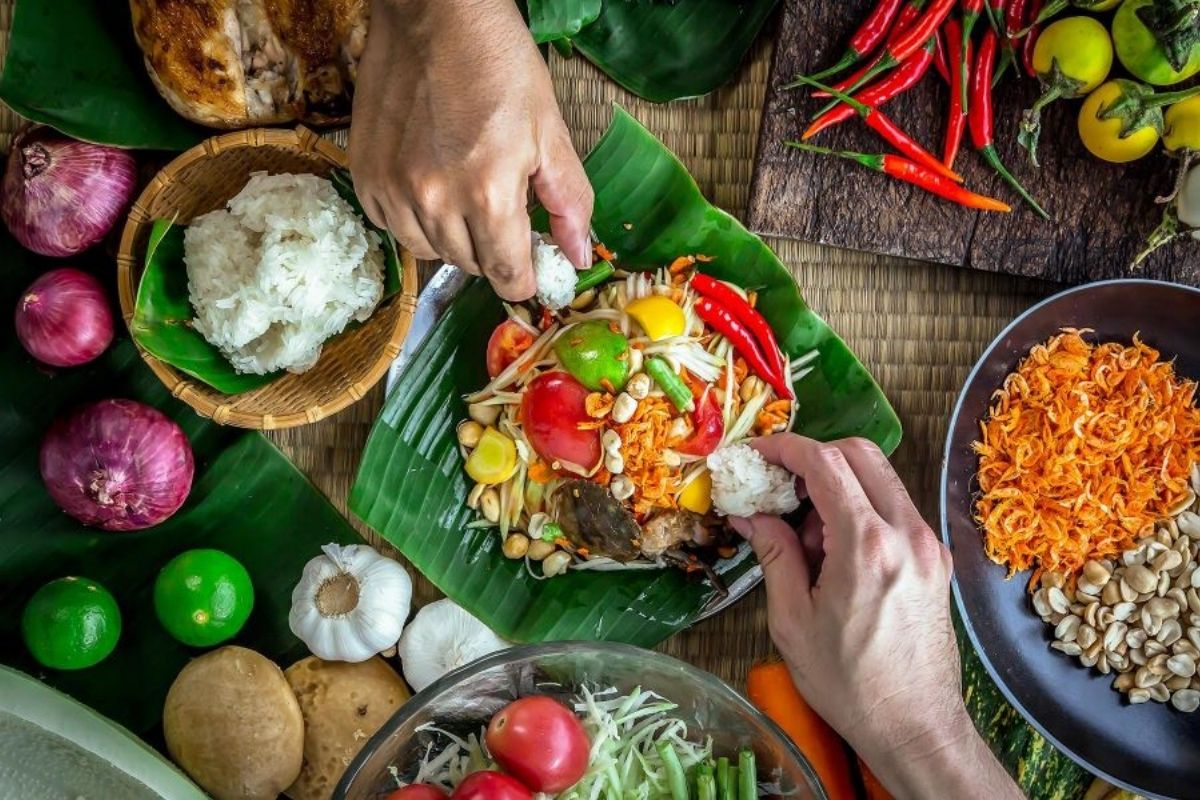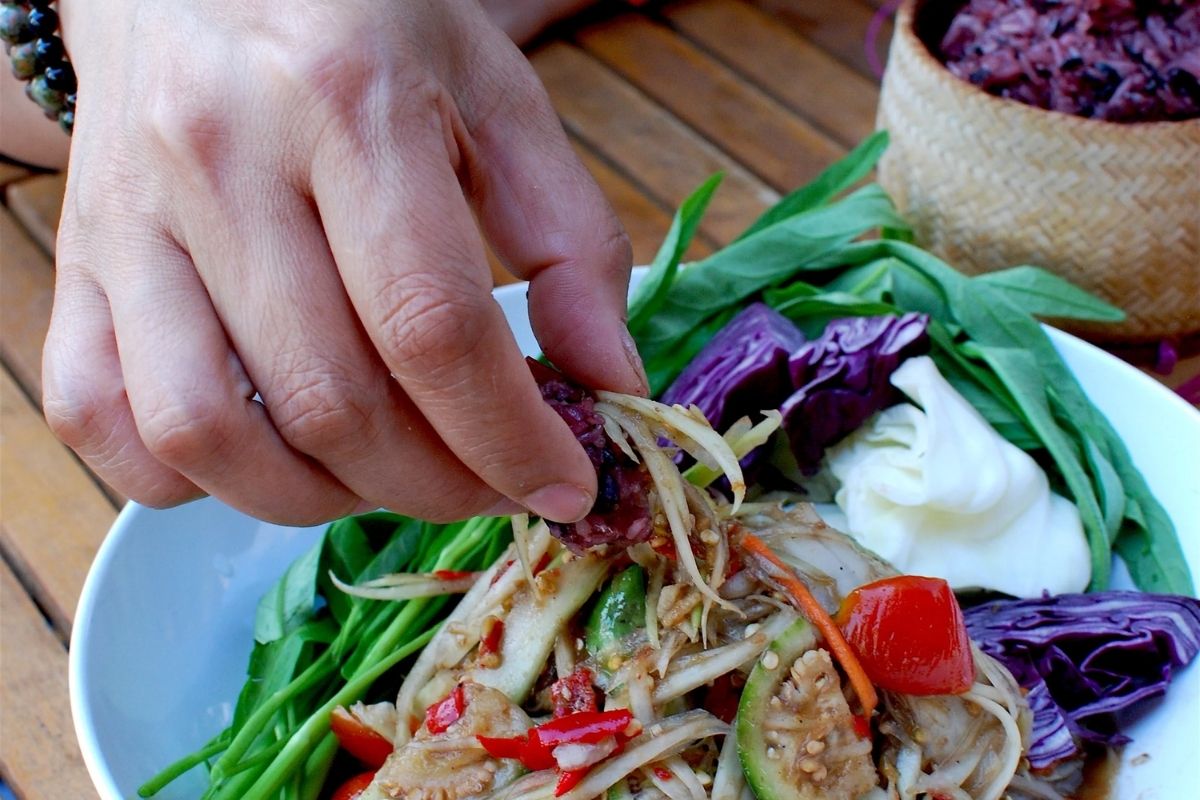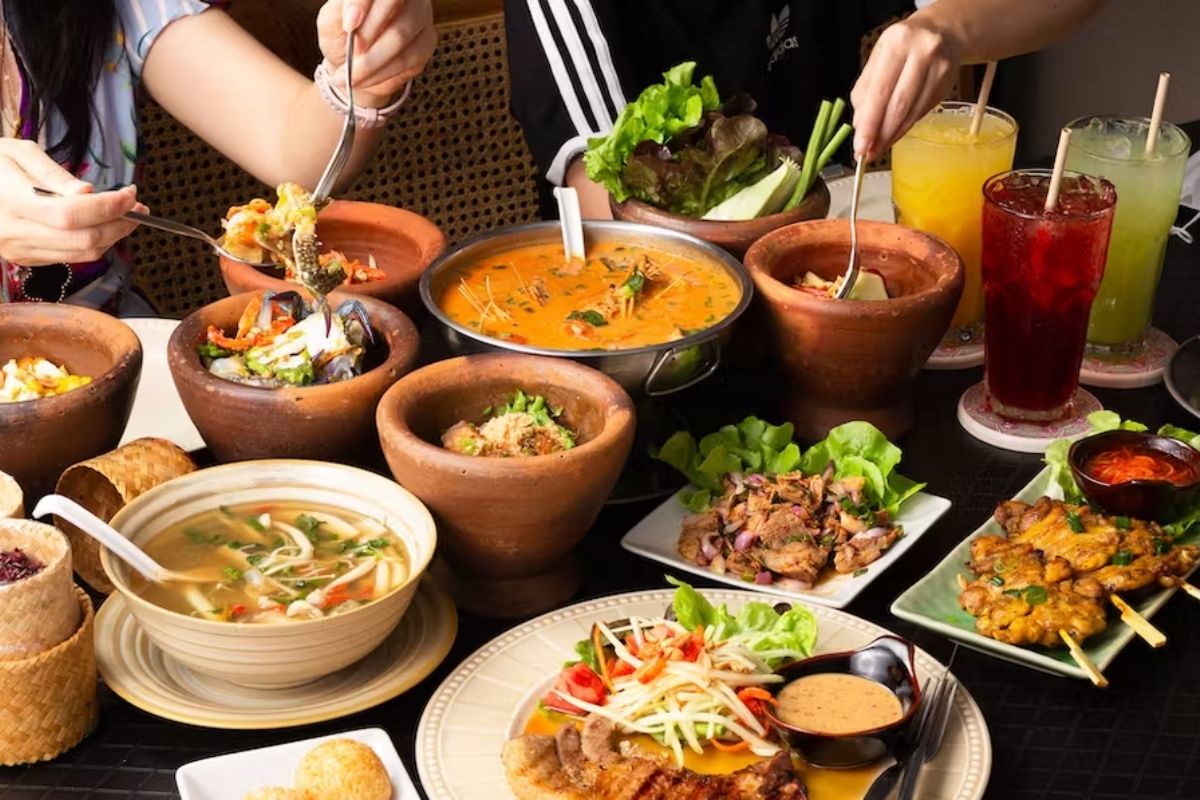Roots and Routes: The True Origins of Lao vs Thai Papaya Salad
The Real Beginning: Laos
Green papaya salad originated in Laos, where it is called tam mak hoong.
In Lao:
- “Tam" means to pound
- “Mak hoong" means papaya
The dish dates back to at least the 19th century and reflects Laos’ unique culinary DNA. Its use of fermented fish sauce (padaek), fresh herbs, and manual pounding techniques make it a cultural symbol and national food of Laos.
The Journey to Thailand
As Lao communities migrated to Northeast Thailand (Isan region), they brought tam mak hoong with them. Over time, local variations emerged, leading to the Thai adaptation now widely known as som tam.
This transition explains why some menus list both “som tam" and “tam mak hoong" without explaining the distinction.
Thai Som Tam: Central Sweetness, Global Fame
Bangkok’s version of green papaya salad—som tam Thai—is what most travelers outside Southeast Asia are familiar with.
What Is The Difference Between Lao and Thai Papaya Salads?
- Uses clear fish sauce instead of padaek
- Adds palm sugar for a more approachable sweetness
- Skips shrimp paste or fermented crab in favor of dried shrimp or peanuts
This modernized version is designed to appeal to international palates, which explains its presence on Thai menus from Los Angeles to London. In rural Thailand, especially during monsoon season, vendors may add local ingredients like hog plum (makok) or white popinac seeds for an extra layer of texture and tartness. These are rarely found in cookbooks but often appear in authentic Thai countryside salads.

Thai Som Tam (Source: grantourismotravels)
Lao Tam Mak Hoong: Fermented Depth and Bold Tradition
This is the original—a rustic, assertive, deeply satisfying dish that reveals the soul of Lao cuisine.
The Heart of the Flavor: Padaek
Padaek is a thick, unfiltered fermented fish sauce that has been aged for months. Unlike Thai fish sauce, it often contains visible fish bits and delivers an unmistakable aroma that defines Lao cooking.
The smell of aged padaek is estimated to be three to four times stronger than Thai fish sauce. For many first-timers, it’s a shock. For locals and seasoned travelers, it’s pure umami magic.
Technique and Tools: Clay Mortars and Deep Pounding
Traditional Lao preparation uses a tall clay mortar and wooden pestle. The clay helps retain the temperature and prevent over-pounding, preserving the crispness of the papaya and releasing flavors gradually. Thai vendors often use shorter wooden mortars, which allow for faster pounding but can alter texture. In contrast, Lao clay mortars ensure a denser, more textured salad

Lao Tam Mak Hoong (Source: toptentravel)
Visual & Sensory Showdown: Color, Texture & Presentation
At first glance, Lao and Thai papaya salads may seem similar. But look again—there’s a whole world of sensory contrast hiding in the bowl.
Color & Visual Density
- Lao tam mak hoong often appears dark brown or muddy because of its rich fermented fish sauce (padaek) and crab paste. The color is bold and intense—just like its flavor.
- Thai som tam is visually lighter: amber or golden from clear fish sauce and palm sugar, making it perfect for food photography and social media posts.
Texture & Mortar Method
- In Laos, traditional cooks use tall clay mortars, which keep the ingredients crisp and cool, perfect for preserving that signature crunch.
- In Thailand, vendors prefer shorter wooden mortars that allow quicker, lighter pounding, but sometimes soften the texture slightly.
Summary of Differences
- Lao salad: darker color, earthier aroma, bolder texture.
- Thai salad: brighter color, sweeter aroma, lighter feel.
These subtle distinctions make a big difference in taste and presentation
Local Flavor Habits: How Locals Eat It Differently of Lao vs Thai Papaya Salad
Understanding how locals eat papaya salad adds a whole new layer to the experience.
In Laos
- Papaya salad is eaten with the left hand, using sticky rice rolled into small balls.
- It’s a shared meal, eaten from a central tray (ka toke) while sitting on the floor.
- Raw vegetables, grilled meat, and sticky rice are always nearby.

Eat Salad Using Left Hand Sticky Rice (Source: feastmeetswest)
In Thailand
- Som tam is usually served on individual plates, eaten with a spoon and fork.
- It’s commonly paired with grilled chicken (gai yang) and sticky rice.
- The combo “som tam + gai yang + khao niao” is a classic Thai street food set.

Som Tam Served With Spoon, Fork (Source: chiangmaicitylife)
Sticky Rice Etiquette Matters
These eating styles reflect deeper cultural values—communal in Laos, practical in Thailand—and enhance your appreciation of local traditions
Ingredient Deep Dive: What’s Inside the Bowl?
At their core, both salads start with similar ingredients: shredded green papaya, fresh chili, garlic, lime, and cherry tomatoes.
But the differences lie in the condiments and finishing touches.
Lao tam mak hoong
- Fermented fish sauce (padaek)
- Crab paste or shrimp paste
- No peanuts, rarely sweetened
Thai som tam
- Clear fish sauce
- Palm sugar
- Often includes roasted peanuts and dried shrimp
Allergen Alert
- Thai version: higher risk for peanut and shellfish allergies.
- Lao version: may still contain shellfish through crab or shrimp paste.
Always ask your server if you have dietary concerns.
Vegetarian Options
- Thai som tam is easier to adapt—fish sauce can be replaced with soy sauce.
- Lao tam mak hoong is much harder to make vegetarian, unless a vendor uses mushroom or tofu-based sauces.
Food Safety Notes for First-Timers try Lao vs Thai Papaya Salad
Before diving into your first bite of papaya salad—especially Lao tam mak hoong—there are a few things to keep in mind for a safe and enjoyable experience.
Raw Crab & Food-Safety Concerns
Many local versions of Lao salad use raw freshwater crab (pu pla ra) or fermented fish that may carry bacteria like Vibrio cholerae or parasites such as lung flukes. These cannot be neutralized by lime juice or chili. If you’re new to this dish, request steamed crab or opt for the plain version—your stomach will thank you.
Health Notes for Vulnerable Groups
- Older Adults: Should limit intake of fermented sauces (like padaek) and avoid raw freshwater crab, which may pose a higher risk of bacterial or parasitic infections.
- Children under 5: Best to avoid very spicy or raw versions of papaya salad. Opt for mild, fully cooked side dishes instead.
- Pregnant Women: Advised to avoid unripe papaya (which contains papain that may trigger uterine contractions) and all raw seafood components.
- Shellfish Allergies: Both tam mak hoong and som tam can contain shrimp paste or crab paste. Always ask vendors or guides about ingredients before ordering.
- Vegetarian Travelers: Thai-style salads are easier to adapt with soy or mushroom-based alternatives; Lao versions are traditionally non-vegetarian due to padaek.
Taste Adjustment Guide: Spice, Sourness, Umami & More
One of the best things about papaya salad—whether Lao or Thai—is its flexibility. With a few tweaks, you can personalize every bite.
How to Adjust the Flavor Profile
- Spice Level: Ask for fewer chilies (start with one). Remove seeds to reduce intensity. Add more sticky rice to balance.
- Sourness: Too tangy? Cut back on lime or tamarind. Add a pinch of sugar.
- Saltiness: Ease up on fish sauce. Squeeze extra lime to balance.
- Umami & Fermentation: New to pungent flavors? Start with Thai som tam, which is milder than the deeply funky Lao version using aged padaek.
- Sweetness: Thai salads usually include palm sugar. You can request “no sugar” or “extra sugar” depending on taste.
Vegetarian Options
- Thai som tam can be made vegetarian using soy sauce instead of fish sauce.
- Lao tam mak hoong is more difficult due to padaek, but some vendors now offer mushroom-based alternatives for plant-based eaters.
Verdict: Lao vs Thai Papaya Salad? It Depends On…
Which version is best for you? That depends on your preferences, dietary needs, and appetite for adventure. Here’s a handy comparison table to guide your choice:
|
Criteria
|
Lao Tam Mak Hoong (ຕຳຫມາກຫຸ່ງ)
|
Thai Som Tam (ส้มตำ)
|
|
Color & Visual Density
|
Deep brown dressing from fermented fish sauce and crab paste, often darker in tone
|
Golden-amber color from fish sauce and palm sugar, often more vibrant in presentation
|
|
Umami / Fermentation Index
|
Distinctive fermented depth using aged padaek; bold and layered
|
Cleaner, lighter umami with balanced use of fish sauce; suitable for a wider range of palates
|
|
Texture & Crunch
|
Shredded papaya with a slightly rustic, hearty bite; robust sauce consistency
|
Finely shredded papaya; crisp and refreshing with a lighter, tangy dressing
|
|
Spice Level
|
Typically bold in heat; adjustable upon request
|
Spice levels can range widely; easily customized for mild to very spicy preferences
|
|
Sweetness Profile
|
Tends toward savory and sour; sweetness is subtle and secondary
|
Noticeable sweetness from palm sugar complements the sour-spicy profile
|
|
Sticky Rice Etiquette
|
Traditionally enjoyed by hand with sticky rice balls; communal-style presentation
|
Commonly served with spoon and fork; often plated individually in urban or restaurant settings
|
|
Mortar Type & Impact
|
Clay mortars retain coolness and support firm pounding, preserving texture and aroma
|
Wooden mortars allow quick, light pounding, creating a smoother, more fluid salad blend
|
|
Allergen Hot-Spots
|
May include crab or shrimp paste; peanuts are rarely added
|
Frequently includes roasted peanuts and dried shrimp; important to note for those with nut or shellfish allergies
|
|
Vegetarian Options
|
Less common due to traditional use of padaek, though some cooks offer alternatives
|
More flexible; fish sauce can be substituted with light soy or mushroom-based sauces in vegetarian versions
|
|
Seasonal Add-ins
|
May include regional ingredients like local plum (mak kok) and fresh herbs, especially during monsoon season
|
Countryside versions may feature hog plum or popinac seeds; flavors vary by region and season
|
Whether you’re a culinary thrill-seeker, a cautious taster, or a wellness traveler, there’s a version of green papaya salad waiting for you. And with Impress Travel’s guided tours, you can experience both sides of the mortar with full cultural and culinary context.
Impress Travel Recommends: Lao Papaya Salad Food Tour
Ready to try tam mak hoong the way locals do? Impress Travel invites you on a hands-on, flavor-packed journey into the heart of Lao cuisine. Choose from two immersive experiences in Luang Prabang, tailored for all types of travelers:
Half-Day Morning Tour (7:00 – 11:30)
|
Time
|
Activity
|
Location
|
Description
|
|
7:00–7:30
|
Hotel pickup
|
Your Hotel
|
Guide from Impress Travel picks you up
|
|
7:30–10:00
|
Cooking workshop
|
The Bamboo Experience
|
Learn tam mak hoong, sticky rice, and jeow dipping
|
|
10:00–10:30
|
Temple visit
|
Wat May Souvannapoumaram
|
Explore Lao Buddhist architecture and culture
|
|
10:30–11:30
|
Salad tasting & wrap-up
|
The Bamboo Experience
|
Enjoy your creations and share food stories
|
Every stop on our Impress Travel papaya salad tours is handpicked to maximize cultural depth and flavor satisfaction. Whether you’re pounding your own salad or sampling street-style versions under lantern lights, this is the Lao culinary adventure you’ve been dreaming of.
Conclusion
So—Lao tam mak hoong or Thai som tam? That’s up to your tastebuds and travel style. Both are delicious, both tell a powerful story, and both are worth discovering. But if you’re ready to experience Lao food like a local, let Impress Travel lead the way—with authentic cooking classes, market adventures, and sticky rice in hand. Let the mortar do the talking. Your next unforgettable bite is waiting.











































